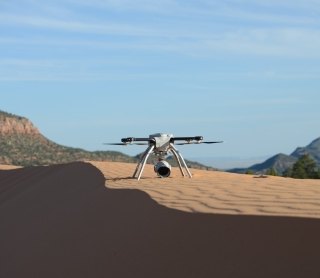
“Data-Up” problem-solving from land, sea, air and space.
There is no one size fits all when it comes to project-based sensor, deployment, and information delivery options. For SWCA, working from the “Data-Up” is a holistic problem-solving approach that begins with listening to client concerns and the science surrounding their projects so pain points and data blind-spots can be identified.
We actively capture and fuse relevant project data in near real time employing a myriad of sensors (payloads/cameras) using robots operating from Land, Sea, Air, and Space. Every project is different, and our data acquisition planners are committed to the development of solutions tailored to your requirements.
SWC.ai, our DigitalGeospatial Visual Intelligence & Data Fusion Platform, leverages a powerful AI/engine driving the rapid rendering of granular actionable intelligence from massive multi-terabyte datasets. SWC.ai is your interactive portal to strategic digital information where you can intuitively view, analyze, annotate, report, share, download, and render critical intelligence in support of key project decisions and reporting.
Relevant Services
- Risk Based Decision Support Systems
- Statistical Analytics & Modeling
- Satellite Imagery Analysis
- Thermal Mapping
- Wetland Mapping
- Archaeological Site Mapping
- Vegetation Density Reporting
- Restoration/Reclamation
- Invasive Species Monitoring
- Construction Monitoring
- Storm Water/Erosion Monitoring
- Endangered Species Monitoring
- Vertical Asset Inspection
- 3D Modeling / As-built
- UAS Land Survey
- Photogrammetry/LiDAR
- UAS Program Development/Management
- Confined Space UAS
- DoD Environmental Compliance
- Application Development
- Assessment & Remediation
- Mining
- Energy/Petrochemical Facility
- Underwater ROV
- Remote Sensing
- Sonar
- Structure from Motion (SFM)
Project Spotlights

Remote Sensing
Flint Creek Remote Sensing
Flint Creek is located in the headwaters of the Upper Clark Fork River Basin southeast of Missoula, Montana. The watershed has a history of disturbance resulting in altered stream processes, impaired vegetation, poor water quality, and poor aquatic habitat. Flint Creek is listed as impaired for metals under the 303 (d) of the Clean Water Act for metals and sediment (DEQ 2012). The source of metals contamination originates from the watershed’s extensive mining history and abandoned mine waste. The source of sediment for the watershed is largely derived from grazing and agricultural activities in the valley floor.
River Design Group, now part of SWCA, was contracted by NRDP to develop a conceptual restoration design for a one-mile reach of Flint Creek. The design will improve stream function for fish populations, improve riparian conditions for waterfowl and other wildlife, and maintain the functionality of the ranching operations occurring on the property.
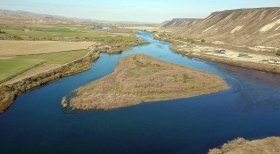
Remote Sensing
Bayha Island Remote Sensing
River Design Group, now part of SWCA, provided planning, design, survey and construction administration services to The Freshwater Trust (TFT) and Idaho Power Company (IPC) during the recent completion of an island enhancement project on the mainstem Snake River near Walters Ferry, Idaho. The intent of the project is to increase water velocity, scour, and depth in the Snake River by expanding the existing footprint of Bayha Island. The project is expected to benefit native species including the endangered Snake River physa snail.
In addition to providing survey and design services for the project elements, our team used unmanned aerial vehicles (UAV’s) to provide construction support surveys by capturing georeferenced aerial imagery during project implementation and by using Structure from Motion (SfM) to create high resolution digital surface models of nearby resource areas. The resulting surface models were then used to estimate the available fill quantities located on site to be placed for the expansion of the island footprint.
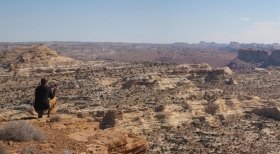
Visual Resources
Seeing Eye to Eye: How Visual Resources Build Consensus on Sustainable Development
We can all see the huge push for renewable energy right now: utility-scale solar developments, onshore and offshore wind farms, and the need for new generation facilities and transmission lines. All these developments have the potential to change what we see and value in the landscape, which is where visual resources expertise helps to analyze and mitigate visual impacts.

Remote Sensing
Lost Trail NWR Remote Sensing
The Lost Trail National Wildlife Refuge is located in the west-central portion of Flathead County, Montana, approximately 25 air miles west of Kalispell and 20 miles northwest of the town of Marion. Encompassing 9,225 acres, the refuge was established as the 519th refuge in the national wildlife refuge system managed by the U.S. Fish and Wildlife Service (USFWS). The historical land use practices significantly altered wetland and aquatic resources within the refuge. Wetlands within the refuge have been impacted by water impoundments, irrigation diversions, wetland drains, and infrastructure including the great northern railroad and pleasant valley road. Pleasant valley creek was straightened and channelized, lowering the groundwater table and resulting in loss of wetland hydrology.
Restoration work includes removing on-stream fish barriers, reconstructing stream channels, improving fish passage conditions at roadway crossings, and restoring and enhancing riparian and floodplain functions associated with pleasant valley creek. To facilitate restoration actions, a portion of pleasant valley road will be relocated out of sensitive wetland and riparian areas. Approximately 5.7 miles of pleasant valley creek will be restored and historical floodplain surfaces reconnected. Approximately 47,000 lineal feet of ditch, which includes wetland drainage ditches, irrigation canals, roadside ditches, and the ditched pleasant valley creek, will be filled. These actions will result in a net increase of 222 acres of wetland habitat on the refuge, mostly consisting of emergent and scrub-shrub wetland types. To facilitate restoration, approximately 3.03 miles of existing road will be relocated from wetlands and floodplains to upland areas. The project is currently being implemented.
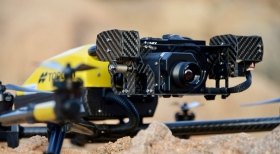
SWCA News
CTO Linda Lannen Shares How SWCA Uses AI and Imaging Technology With Environmental Business Journal
The Environmental Business Journal (EBJ) recently interviewed SWCA’s Chief Technology Officer Linda Lannen for its Q3 2023 Technology & the Environmental Industry issue. The report is an analysis of technology deployment, investment, spending, service offerings, research and development, and long-term aspirations of companies and executives for the future of the environmental and climate change industries.
Lannen shared insight into how SWCA uses advanced imaging technology, artificial intelligence (AI), large language models like ChatGPT, and other technology to provide clients with high-quality data more quickly so that they can make better decisions that positively impact their business and the planet.
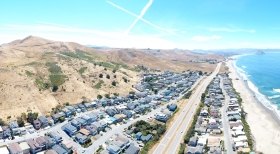
The Wire, Volume 17, No. 3
The Sky's the Limit: 5 Ways SWCA is Using Drones to Solve Client Problems
It’s not surprising that drones have made their way into environmental consulting projects. Over the past year, SWCA has seen its list of certified Unmanned Aerial System (UAS) pilots grow from one to nearly a dozen nationwide. Curious how drones have come into play for our industry, we recently took inventory of all the projects that have benefitted from their use.
Take the Next Step
Request more information for proposals and cost estimates regarding our data acquisition services.